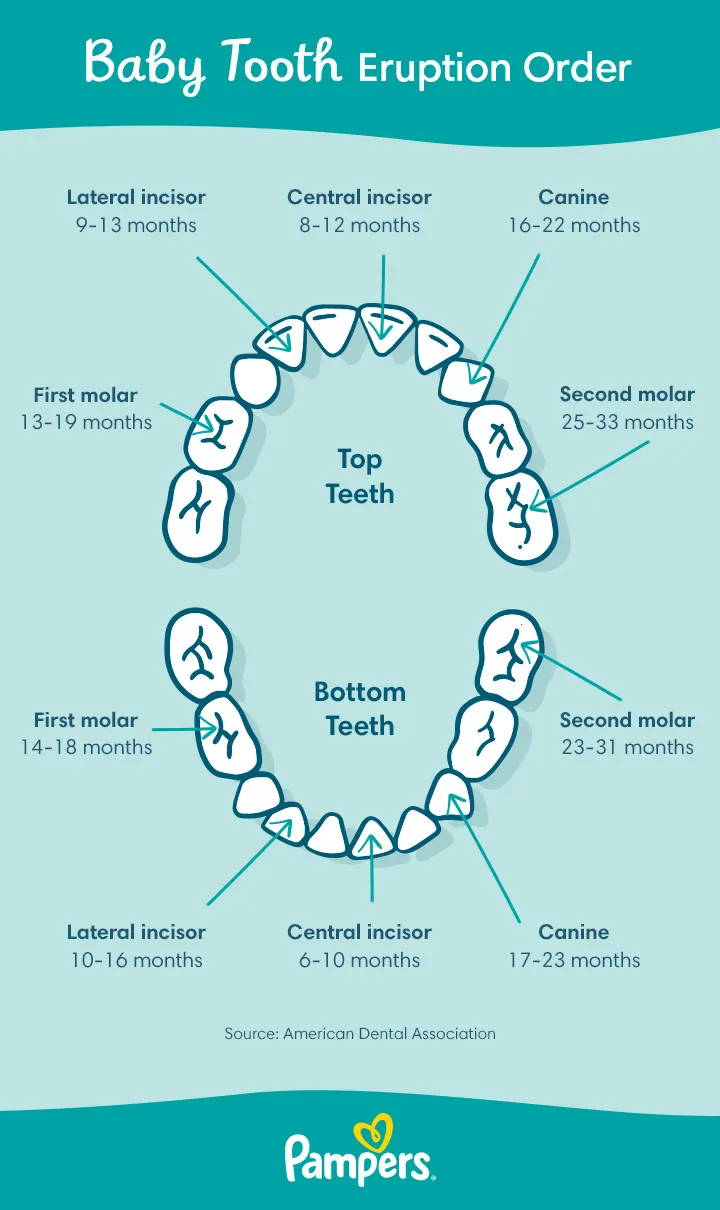The Baby Teeth Eruption Chart: All You Need to Know
As your baby grows, you'll start looking for those first tiny teeth to poke through the gums — an exciting milestone. Although the teething period can be hard for some babies, the upside is that you have lots of toothy grins to look forward to.
Discover when your baby’s first tooth is likely to erupt, as well as what in what order the rest of your baby’s teeth will come in, and at what age. Our baby teeth chart will make it easier to get a handle on which tooth is which!
Baby Teeth Chart
A baby teeth chart shows you when each of your little one’s first set of teeth — known as primary teeth, baby teeth, or deciduous teeth — is likely to come in and then fall out.
Although the exact age when a tooth erupts or falls out will vary from child to child, the baby teeth chart below is a rough guide to when babies typically get their teeth.

In What Order Do Baby Teeth Appear?
Teething usually begins around the ages of 6 to 12 months, although for some babies a tooth can appear as early as 4 months or later than 12 months.
Most of the time, the two front teeth — the central incisors — on either the top or bottom row make their appearance first. Often these are then followed by the opposite front teeth, then the first molars, followed by the canines.
Teeth usually fill in, often in pairs, with one on each side of the upper or lower jaw, until all teeth have arrived. Usually by the time your child is 2 1/2 to 3 years old, all of the primary teeth will have erupted.
The table below shows an approximate age range for when each tooth will come in as an alternative to the baby teeth chart.
How Many Teeth Do Babies and Kids Have?
In total, 20 baby teeth come through. There are 10 on the upper jaw (top teeth) and 10 on the lower jaw (bottom teeth).
Your little one’s mouth will gradually become filled with these teeth up until the age of 3. Then, these primary teeth will begin falling out around the age of 6 to make way for your child’s adult teeth.
Can Teething Be Painful for Babies or Toddlers?
For some babies, teething is painless, but for others it may occasionally cause mild irritability, crying, and even a low-grade temperature.
Much of the discomfort comes from the gums around the new teeth as they erupt, which can become swollen and tender.
If your baby or toddler is showing signs of discomfort and you think it may be due to teething, contact your child’s healthcare provider or dentist for personalized advice. You can also read more on how to soothe a teething baby here or consider a teething toy as a way to help soothe your little one.
At What Age Do Baby Teeth Fall Out?
The first primary teeth begin to fall out when a child is around 6 or 7 years old. The table below offers an approximate age rage for when each tooth typically falls out. Keep in mind, this table shows an average range and it may happen a little differently for your child.
The Bottom Line
It’s exciting seeing that first baby tooth, and a baby teeth chart can provide a rough idea of when the rest of your baby’s teeth will come in. Just remember that every child’s development is different, so your little one’s teeth may follow a slightly different timeline. At this time, you might also be interested in reading up on how to care for your baby’s teeth and when your baby’s first dentist visit should be.
How We Wrote This Article The information in this article is based on the expert advice found in trusted medical and government sources, such as the American Academy of Pediatrics and the American College of Obstetricians and Gynecologists. You can find a full list of sources used for this article below. The content on this page should not replace professional medical advice. Always consult medical professionals for full diagnosis and treatment.
Join a World of Support
through Pregnancy and Parenthood.
TRACK WITH TOOLS
LEARN WITH EXPERTS
GET REWARDED




